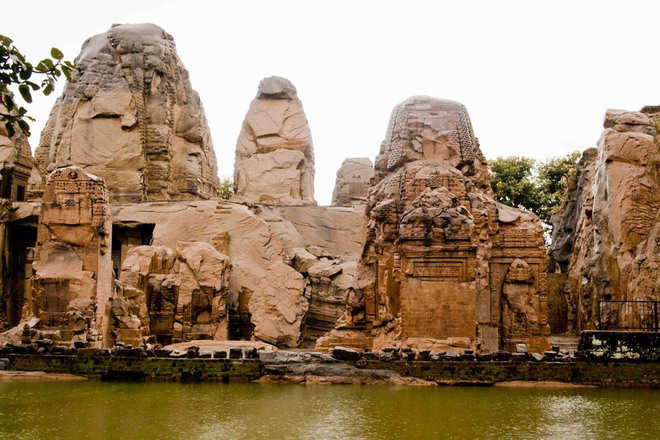Rock-cut temples in Masrur turning into ruins
Lalit Mohan
Tribune News Service
Dharamsala, February 6
The famous rock-cut temples in the Masrur area of Kangra district are fast decaying. The temples carved out of a single sand rock are unique as these are above the surface whereas other rock-cut temples in India are below the surface. However, sand composition of rock that is prone to damage due to weathering has also become the weakness of the temple structure. Heavy rains that lash Kangra are hastening the damage to the temple.
The temples are now under the protection of the Archeological Survey of India (ASI). Though extensive damage was caused to the temples after the 1905 earthquake in Kangra district, the ASI managed to restore many portions. Sources said the ASI tried to protect the temple from weathering using some chemical treatment that hardens the sand rock and delays its decay due to rain and other weathering factors. However, it has also not proved to be that effective. At some places, even cement has been used to strengthen the temple structure.
Prof NK Singh, who has written a book on the temples, said international experts should be hired to protect the structures. The state should also contribute to the protection of the temple as it was a part of the heritage of Himachal.
Rock-cut temples located in small and remote hamlet Masrur have been an enigma for historians and archeologists. Even Archeological Survey of India officials, who are maintaining the site, are not sure about history of temples.
However, the book by Prof NK Singh ‘Coronation of Shiva Rediscovering Masrur temple’ has tried to resolve the mystery.
The Masrur temples are one of the four monolithic rock-cut temples in the country. Two of these, including Kailash of Ellora and Mamlapuram in Deccan, are famous across the world. The third is Dhamnar located in Rajasthan and the fourth is Masrur’s. While the other three temples are in a pit or on the ground, Masrur is unique due to the fact that it is located on a hilltop at a height of about 2,500 feet.
Some are of the view that the temples are similar to Angokar temples found in Cambodia in terms of design.
As per the local mythology, just like many temples in the region, the Masrur temples were also built by the Pandavas.
However, Prof NK Singh in his book has opined that thse were built during the 6th-8th century. He has based his opinion on the fact that before this period, there was no evidence of rock-cut temples in the country. Most of the temples in the country were build during this period. After the 8th century, there was chaos in the region and rulers did not have resources or time to take up such a huge project.
By deliberating on the fact that the king who built the temples was a Lord Shiva devotee and had huge resources, NK Singh concluded that most likely it was Yashoverdhan, who had got the Masrur temples built. He has, however, said the issue was still open for research by the historians and archeologists.
The Masrur temples are believed to have been cut out of a single rock measuring 160 feet in length and 105 feet in width. Shuttleworth was the first British civil servant who mentioned about rock-cut structure of Masrur temples. The large water tank facing the main temple is also cut out of rock and has perrineal water source from some spring.
Structures being managed by ASI
- The temples are now under the protection of the Archeological Survey of India (ASI).
- Though extensive damage was caused to the temples after the 1905 earthquake in Kangra district, the ASI restorec many portions.
- Prof NK Singh, who has written a book on the temples, wants international experts to protect the structures.
- Temples have been an enigma for historians and archeologists.









